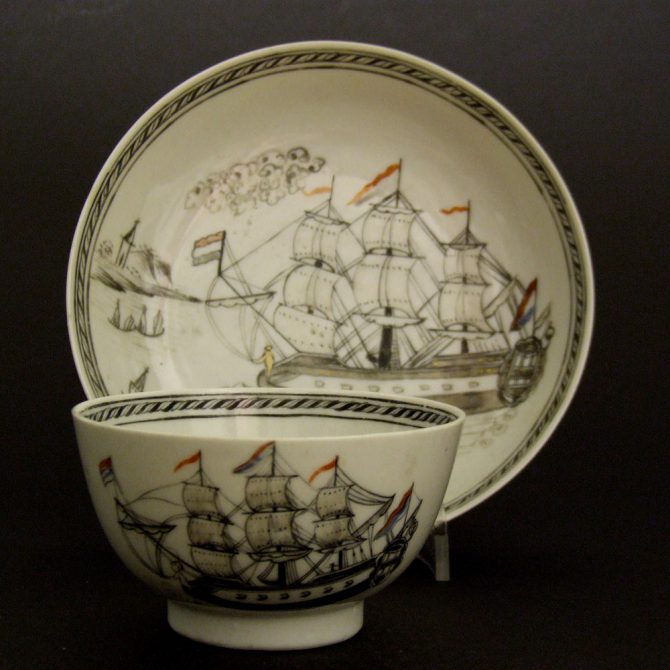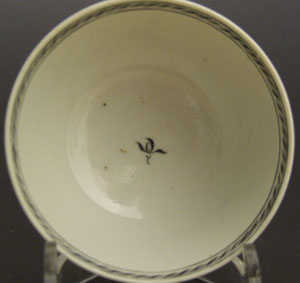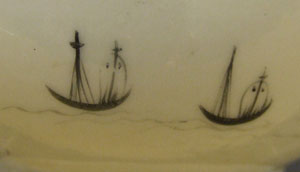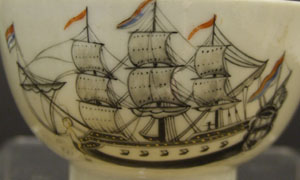
QIANLONG 1736 – 1795 Chinese Export Porcelain
An Unusual 18th Century Chinese Export Porcelain Teabowl and Saucer. Decorated in En Grisaille with a Dutch Man-of-War. The Ship, Probably Belonging to the Dutch East India Company (Vereenigde Oost-Indische Compagnie) has Three Mast, and is Presumably Depicted Near the Chinese Coast, Qianlong Period c.1760-1780. Decorated in En Grisaille with the Flags Picked-Out in Enamel Colour.
Some reference books describe Chinese export porcelain ship subject porcelain like the present example as being of standard patterns ready to be customized for the client by painting in the appropriate flag at the last minute. This seems highly unlikely as it would necessitate an extra firing. However in this example he flags were picked out in colour so that the identity of the ship could be clearly shown.
SOLD
- Condition
- In perfect condition. The painting of the ships hull is a bit pale, certainly when compared to the teabowl, but this doesn't appear to be due to wear as the gilding on the hull is un-rubbed.
- Size
- Diameter saucer : 12.8 cm (5 inches)
- Provenance
- N/A
- Stock number
- 22874
- References
- For a saucer of this design given a rather early date of c.1745 from the collection of A. Costa in Lisbonne see : La Porcelaine Des Compagnies Des Indes A Decor Occidental (Francois et Nicole Hervouet, Yves Bruneau. Flammarion, 1986. ISBN 2-08-010990-1) page 40, plate 2.12. For another Chinese Export Porcelain teabowl and saucer of this design see : Fine Chinese Export Porcelain From The Collection of Angelo Castelo Branco Cerqueira Caldas, Sotheby`s London, 8th May 1990 lot 80.
Information
The V.O.C. :
The Dutch East India Company (Vereenigde Oost-Indische Compagnie or V.O.C. in Dutch, literally "United East Indian Company") was a chartered company established in 1602, when the States-General of the Netherlands granted it a 21-year monopoly to carry out colonial activities in Asia. It was the first multinational corporation in the world and the first company to issue stock. It was also arguably the world`s first mega-corporation, possessing quasi-governmental powers, including the ability to wage war, negotiate treaties, coin money, and establish colonies. Statistically, the V.O.C. eclipsed all of its rivals in the Asia trade. Between 1602 and 1796 the V.O.C. sent almost a million Europeans to work in the Asia trade on 4,785 ships, and netted for their efforts more than 2.5 million tons of Asian trade goods. By contrast, the rest of Europe combined sent only 882,412 people from 1500 to 1795, and the fleet of the English (later British) East India Company, the V.O.C.’s nearest competitor, was a distant second to its total traffic with 2,690 ships and a mere one-fifth the tonnage of goods carried by the V.O.C.. The V.O.C. enjoyed huge profits from its spice monopoly through most of the 1600s. The Dutch East India Company remained an important trading concern for almost two centuries, paying an 18% annual dividend for almost 200 years. In its declining years in the late 18th century it was referred to as Vergaan Onder Corruptie (referring to the acronym VOC) which translates as `Perished By Corruption`. The V.O.C. became bankrupt and was formally dissolved in 1800, its possessions and the debt being taken over by the government of the Dutch Batavian Republic. The V.O.C.`s territories became the Dutch East Indies and were expanded over the course of the 19th century to include the whole of the Indonesian archipelago, and in the 20th century would form Indonesia. Information supplied by wikipedia at http://en.wikipedia.org/wiki/Dutch_East_India_Company.





